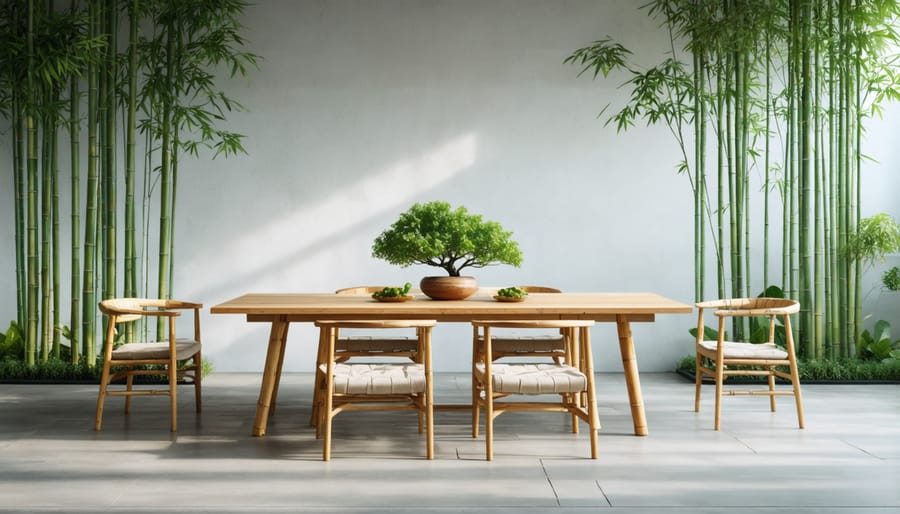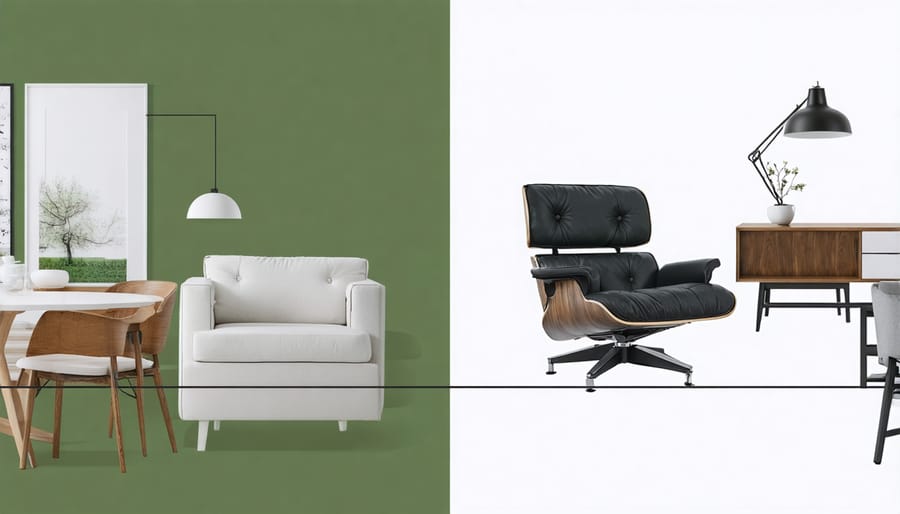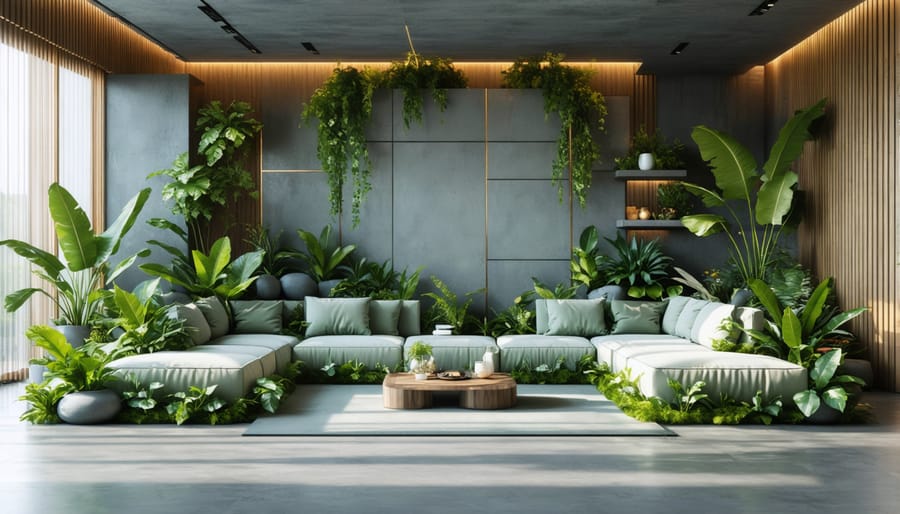Transform your living space into an eco-conscious sanctuary with modern sustainable furniture that combines cutting-edge design with environmental responsibility. Today’s sustainable furniture goes far beyond reclaimed wood and recycled materials, embracing innovative manufacturing processes, breakthrough bio-materials, and sophisticated aesthetics that rival traditional luxury pieces.
From bamboo dining sets that grow to maturity in just five years to modular sofas crafted from ocean-recovered plastics, sustainable furniture has evolved to meet the demands of style-conscious consumers who prioritize both planet and design. Leading manufacturers now utilize advanced techniques like 3D-printed biodegradable components, zero-waste production methods, and cradle-to-cradle certification to create pieces that minimize environmental impact without compromising on form or function.
Whether you’re furnishing an entire home or selecting statement pieces, choosing sustainable furniture means investing in both your space and our planet’s future. The latest designs prove that eco-friendly choices can be sophisticated, durable, and surprisingly affordable, offering modern aesthetics that complement any interior style while supporting responsible manufacturing practices and reducing your carbon footprint.
[Word count: 138]
What Makes Modern Furniture Truly Sustainable?
Eco-Friendly Materials Revolutionizing Furniture Design
Today’s furniture designers are pushing boundaries with innovative eco-friendly materials that combine style with environmental responsibility. Bamboo leads the charge as a rapidly renewable resource, offering strength comparable to hardwood while growing up to 20 times faster than traditional timber. Its natural beauty and versatility make it perfect for everything from dining tables to bedroom sets.
Reclaimed wood tells a unique story in every piece, breathing new life into materials that might otherwise end up in landfills. Whether sourced from old barns, industrial buildings, or retired shipping pallets, these characterful pieces add warmth and history to modern spaces.
Recycled metals are making waves in contemporary furniture design, with aluminum and steel being reformed into sleek chairs, table bases, and decorative elements. These materials not only reduce mining impact but require significantly less energy to process than virgin metals.
Bio-plastics represent the cutting edge of sustainable furniture materials. Made from renewable resources like corn starch or vegetable fats, these innovative materials offer the durability of traditional plastics without the environmental drawbacks. They’re particularly popular in outdoor furniture and accent pieces.
Cork is another rising star, offering natural water resistance and unique textural elements while being completely renewable. It’s finding its way into everything from ottoman covers to chair cushions, proving that sustainability can be both practical and beautiful.

Sustainable Production Practices
Today’s sustainable furniture manufacturers are revolutionizing production methods to minimize environmental impact while creating beautiful, durable pieces. Many companies now use closed-loop manufacturing systems, where waste materials are recycled back into production, significantly reducing landfill waste. For example, wood scraps are transformed into engineered wood products or used as biofuel to power facilities.
Water conservation plays a crucial role in sustainable production. Advanced filtering systems allow manufacturers to reuse water multiple times in their processes, while low-flow technology reduces overall consumption. Similarly, energy-efficient machinery and solar-powered facilities help decrease the carbon footprint of furniture production.
Smart factory layouts and lean manufacturing principles help optimize material use and reduce waste. Companies are increasingly adopting made-to-order models, which prevent overproduction and ensure resources are used only when needed. Many manufacturers also partner with local suppliers to shorter transportation distances and reduce emissions.
Packaging has evolved too, with biodegradable materials replacing traditional plastic wrapping. Some companies use blanket wrapping for local deliveries, eliminating packaging waste entirely. Digital design tools help manufacturers precisely calculate material needs, minimizing offcuts and waste during production.
These sustainable practices often result in higher initial production costs, but many manufacturers find that long-term savings and increased consumer support make these investments worthwhile. As technology advances, we’re seeing these practices become more efficient and cost-effective, making sustainable furniture production increasingly viable.

Style Meets Sustainability: Top Trends
Minimalist Eco-Design
In the world of sustainable furniture, less truly is more. The marriage of minimalist design principles with eco-friendly practices creates a perfect harmony that benefits both our homes and the environment. By focusing on clean lines, essential forms, and thoughtful material selection, minimalist sustainable furniture reduces waste while maximizing functionality.
This approach emphasizes quality over quantity, encouraging the use of fewer, better-made pieces that last longer and create less environmental impact. Think solid bamboo coffee tables with simple geometries, or sleek reclaimed wood dining sets that showcase the natural beauty of their materials. The beauty of minimalist eco-design lies in its ability to make sustainable materials the star of the show, without unnecessary embellishments or excess components.
Moreover, minimalist furniture typically requires fewer resources to produce and transport, thanks to its streamlined designs. This efficient use of materials not only reduces the carbon footprint but also often results in more affordable pieces that maintain their aesthetic appeal for years to come. When choosing minimalist sustainable furniture, look for pieces that serve multiple purposes and adapt easily to different spaces, ensuring longevity in both style and function.
Biophilic Elements
Bringing the outdoors inside has become a cornerstone of modern sustainable furniture design. Biophilic elements seamlessly blend natural materials and organic shapes with contemporary aesthetics, creating pieces that nurture our innate connection to nature. Look for furniture that incorporates living elements like moss walls in room dividers or planters built into coffee tables.
Natural materials take center stage in biophilic furniture design. Think reclaimed wood with visible grain patterns, cork surfaces, bamboo components, and stone accents. These materials not only minimize environmental impact but also create a sensory-rich experience through varying textures and organic patterns.
Shapes and forms inspired by nature are equally important. Curved lines mimicking river flows, fractal patterns reminiscent of leaf veins, and asymmetrical designs that echo natural growth patterns are common features. Colors typically follow nature’s palette, incorporating earth tones, forest greens, and ocean blues.
Consider furniture pieces that serve dual purposes, like modular shelving units with integrated plant holders or dining tables with built-in herb gardens. These thoughtful designs help create a living, breathing space that connects us to nature while maintaining modern functionality.
Multifunctional Pieces
In today’s space-conscious world, multifunctional furniture pieces are revolutionizing how we think about sustainable living. These clever designs serve multiple purposes while reducing our environmental footprint and maximizing living space.
Consider the modern modular sofa that transforms into a guest bed, complete with storage compartments made from recycled materials. Or the expandable dining table crafted from sustainably harvested bamboo, which can shift from an intimate breakfast nook to a dinner party centerpiece in moments.
Wall-mounted desks that fold away when not in use are another brilliant innovation, often incorporating shelving systems that make the most of vertical space. Many of these pieces are constructed using reclaimed wood, giving new life to materials that might otherwise end up in landfills.
Ottoman coffee tables with hidden storage compartments are perfect for small living spaces, while convertible console-to-dining tables offer flexibility for entertaining. Look for pieces certified by the Forest Stewardship Council (FSC) to ensure your furniture comes from responsibly managed forests.
Smart design features like these not only help reduce waste by eliminating the need for multiple pieces of furniture but also encourage a more minimalist lifestyle. When shopping for multifunctional pieces, consider durability and timeless design – furniture that lasts longer inherently becomes more sustainable.
The best part? These space-saving solutions often cost less in the long run while helping you maintain a cleaner, more organized living space.

Investing in Sustainable Furniture
Quality Markers
When shopping for sustainable furniture, knowing what to look for can make all the difference. Start by checking for recognized certifications like FSC (Forest Stewardship Council) or GREENGUARD, which verify that the furniture meets specific environmental standards. These labels should be clearly displayed on the product or packaging.
Pay attention to the materials used. Genuine sustainable furniture often features reclaimed wood, bamboo, or recycled materials. Look for natural finishes and water-based adhesives rather than toxic chemicals. The manufacturer should be transparent about their material sourcing and production methods.
Quality sustainable furniture should come with detailed information about its environmental impact, including its carbon footprint and end-of-life recyclability. Check if the manufacturer has a take-back program or provides guidance on responsible disposal.
Don’t be fooled by “greenwashing.” Authentic sustainable furniture makers will provide specific details about their eco-friendly practices rather than using vague terms like “eco-friendly” or “green” without explanation. They should also be able to demonstrate their commitment to sustainability through documented practices and partnerships.
Look for furniture that’s built to last. True sustainable pieces are designed for durability and repair rather than replacement. Check the construction quality, joinery methods, and warranty terms. A longer warranty often indicates the manufacturer’s confidence in their product’s longevity, which is a key aspect of sustainability.
Care and Longevity
Proper care of your sustainable furniture isn’t just about maintaining its appearance – it’s about extending its lifespan and reducing the need for replacement, which is crucial for environmental conservation. Start by placing wooden pieces away from direct sunlight to prevent fading and warping. For upholstered items, regular vacuuming and prompt stain treatment using eco-friendly cleaners will keep them looking fresh.
Consider protective measures like furniture pads under legs to prevent floor damage and coasters for water rings. When moving pieces, always lift rather than drag to maintain structural integrity. For wooden furniture, apply natural oils or waxes every 6-12 months to nourish the material and prevent drying.
If your furniture shows signs of wear, don’t rush to replace it. Many pieces can be restored through upcycling furniture pieces with eco-friendly finishes and materials. Small repairs, like tightening loose joints or replacing worn fabric with sustainable textiles, can add years to your furniture’s life.
Keep metal components rust-free by wiping them regularly with a dry cloth, and address any scratches or damage promptly to prevent deterioration. By following these care guidelines, your sustainable furniture can remain beautiful and functional for generations, reducing waste and supporting environmental consciousness.
Making the Switch
Transitioning to sustainable furniture doesn’t have to happen overnight. In fact, a gradual approach often proves more effective and budget-friendly. Start by assessing your current furniture and identifying pieces that need replacement first. This thoughtful evaluation helps create a realistic timeline for creating eco-friendly living spaces without overwhelming your resources.
Begin with smaller items like side tables or accent chairs, which typically require less investment. This allows you to experiment with different sustainable materials and makers while building confidence in your choices. As you replace pieces, consider setting aside a dedicated “furniture fund” – even a small monthly contribution can add up to afford higher-quality sustainable pieces over time.
When shopping, prioritize versatile pieces that serve multiple functions or can easily transition between different room setups. Look for furniture made from certified sustainable wood, recycled materials, or innovative eco-friendly alternatives. Many sustainable furniture brands offer financing options or seasonal sales, making premium pieces more accessible.
Don’t overlook the potential of existing furniture. Before replacing items, explore upcycling possibilities. A fresh coat of non-toxic paint, new hardware, or professional reupholstering with sustainable fabrics can extend the life of quality pieces while reducing waste. Local craftspeople often offer these services at reasonable rates.
Consider these practical steps for a smooth transition:
1. Create a priority list of items to replace
2. Research sustainable alternatives and their price points
3. Set a realistic monthly budget for new purchases
4. Look for multi-functional pieces to maximize value
5. Explore secondhand markets for vintage sustainable materials
6. Connect with local artisans for custom sustainable solutions
Remember that sustainable furniture often costs more upfront but provides better value through durability and timeless design. Focus on quality over quantity, and don’t feel pressured to replace everything at once. The goal is to make mindful choices that align with both your values and your budget, creating a beautiful, sustainable home one piece at a time.
As we’ve explored, modern sustainable furniture represents more than just a trend – it’s a meaningful step toward a more environmentally conscious lifestyle. By choosing eco-friendly materials, supporting sustainable manufacturing practices, and investing in durable pieces, we can create beautiful, environmentally responsible living spaces that stand the test of time. Whether you’re starting small with a single piece or planning a complete home transformation, every sustainable furniture choice makes a positive impact. Remember that style and sustainability can coexist beautifully, offering both aesthetic appeal and peace of mind. As more manufacturers embrace green practices and innovative materials, sustainable furniture continues to become more accessible, diverse, and design-forward. Make your next furniture purchase count – for your home and for our planet.
